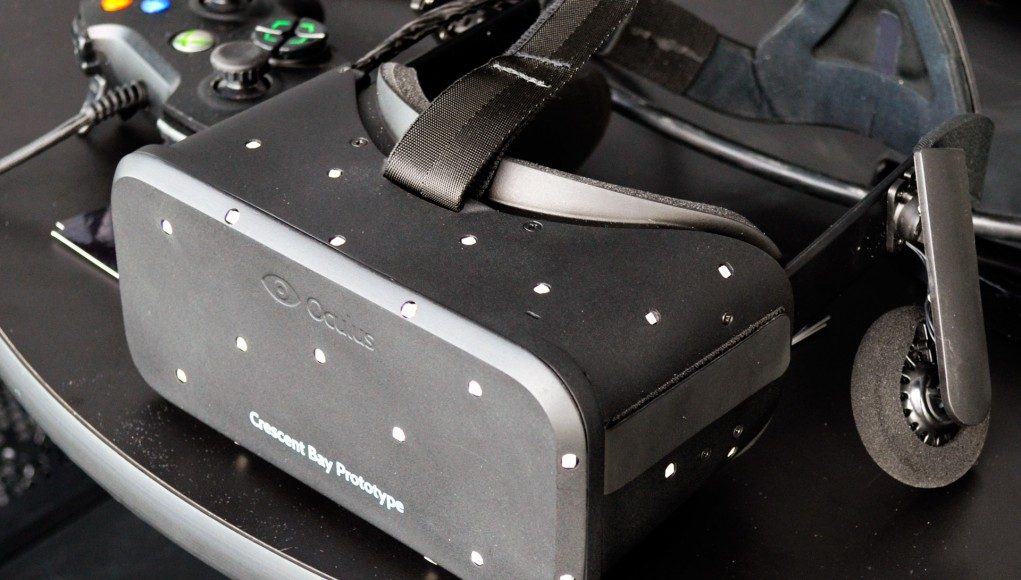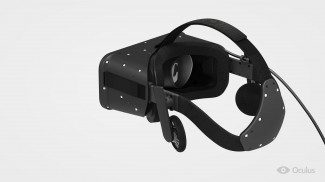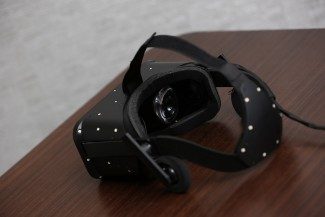It’s difficult to get a real sense of Crescent Bay, Oculus’ latest Rift prototype, because outsiders are only ever in the headset for a few minutes at a time. Having now logged a number of sessions, I’m starting to get a solid feel for the headset and have collected some of my thoughts on its subtleties.
Lenses
In my latest session with the headset, I triple checked that it uses Fresnel lenses. I was 99% sure I’d seen this when I used the headset a few weeks ago at GDC 2015, but after double-checking some photos which didn’t appear to reveal the characteristic Fresnel ridges, I was a little worried that I might have mixed memories from my time with the HTC Vive and Sony Morpheus. After my triple-check though, I’m sure. The ridges are much more fine than those on the HTC Vive, and they appear to be ‘inside’ of the lens (which could hint at a multi-element lens)—probably why no one seems to have noticed, even though Crescent Bay has been floating about since September.
In the early days of the Rift, creator Palmer Luckey didn’t think Fresnel lenses would be a good fit for the headset, as he shared on the Oculus section of Reddit:
Because they kill contrast, add a variety of annoying artifacts, and don’t actually save all that much weight. They don’t help with form factor, either; Fresnels cannot come close to matching the focal length/magnification of other optics tech.
I asked Luckey about his latest thoughts on Fresnels but he opted not to comment.
Light Rays

I’ve also reaffirmed the existence of a new visual artifact that I’ve noticed on Crescent Bay which the DK2 lacks; I believe it may due to the Fresnel lenses, as I’ve noticed the same artifact on the HTC Vive. The best words I can use to describe it are ‘light rays’. They seem to be present on high contrast scenes (especially white on black), and appear to change direction as the image moves about the scene. For the most part, the light rays seem not to be very noticeable during an average scene, but they stand out in those with high contrast.
See Also: First Hands-on – Oculus Rift Crescent Bay is Incredible
Black Smear
On a positive note, black smear, one of the DK2’s biggest display issues, has nearly been eliminated. Black smearing is the result of the display’s pixel switching time being slow when switching between true black and other colors. I’m not sure if this is a hardware fix or possibly a software approach (which could be achieved by using a 99% dark grey instead of true black), but it’s a huge improvement, especially in dark scenes. I believe I still see a faint ghosting effect, but it isn’t clear if this is related to black smear.
Display
Since the reveal of Crescent Bay at Oculus Connect in September 2014, the company has been extremely tight-lipped about the display. They still haven’t released hard details on the display tech or resolution.
I previously speculated that it was using a 2560×1440 display, as I’ve found the image quality to be comparable between Gear VR and Crescent Bay. But after seeing the HTC Vive (which has a known resolution), and the recent revelation that there are actually two displays inside the headset, my guess is that it uses the same 1200×1080 (per-eye) displays as the HTC Vive, providing a total effective resolution of 2160×1200.
Although at this resolution it has become hard to tell, I’m fairly certain that the display uses the PenTile subpixel structure, just like the DK2 and Note 4 (which powers Gear VR).
It seems to me that Crescent Bay’s saturation is lacking compared to the DK2, but it’s tough to say without a side by side comparison.
See Also: HTC Vive and SteamVR Hands-on – A Stage of Constant Presence
Ergonomics and Field of View
The improvements to Crescent Bay’s ergonomics are not quite appreciable if you’re only spending 5 minutes in the headset at a time. It’s the long-term comfort that’s important.
Crescent Bay is better fitting and much lighter than the DK2, I would guess by at least 15%. Inside the headset, there seems to be more space around your eyes, making the whole thing feel more roomy and breathable, though this comes at the cost of a larger opening around the nose which can let light into the headset, whereas the DK2 is nearly completely enclosed from the outside.
The headband seems to dodge the ears much more effectively, eliminating the irritating feeling of the DK2’s straps trying their hardest to slice off your ear during a long session.
There’s not much to say about the field of view other than that it’s noticeably larger, by about 10%. I’ll take all I can get!









